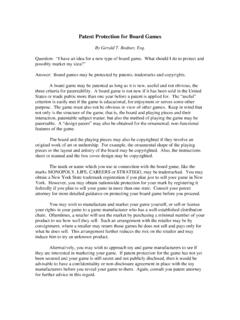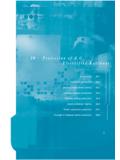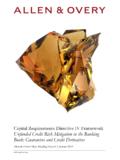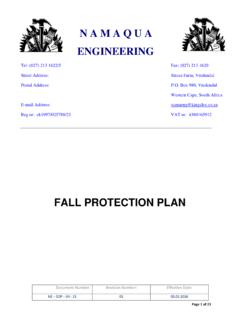Transcription of Guidance for carrying out risk assessment at …
1 SAFETY AND HEALTH COMMISSION FOR THE mining AND OTHER EXTRACTIVE INDUSTRIES Doc. No 5995/2/98-EN Amended by the SHC on (Doc. 1175/01-EN) Committee on Surface Workings Guidance FOR carrying OUT RISK assessment AT SURFACE mining OPERATIONS 2 Introduction This publication sets out basic advice for carrying out Risk assessment at Surface mining Operations. Surface mining operations are defined as activities undertaken during winning, transporting and processing of minerals mined from the surface. The steps to carry out the necessary risk assessment before each operation is carried is addressed in this publication. Risk assessment . Definition. Risk assessment is all about prevention of accidents and there is a need to be aware that there is the risk of an accident before steps can be taken to prevent it happening.
2 It may not always be obvious that a workplace task could lead to an accident. This is why risk assessments are carried out. In risk assessment the words Hazards and risks are often used and it is necessary to be clear what Hazards and risks are:- A hazard is anything that has the potential to cause harm. The risk is how likely it is that a hazard will cause actual harm. Having defined the work to be undertaken risk assessment will give a clearer picture of what could go wrong and how serious an accident could be. It will depend upon following a set model which will enable the risk to be assessed. 3 General principles. The core of any risk assessment is the application of basic health and safety principles.
3 In the context of this publication the following precautionary principles are applicable. House keeping - the provision and maintenance of a safe and healthy workplace is the most basic principle of health and safety. Dirty and untidy workplaces or walkways contribute to a very large proportion of trip and fall accidents. In the context of surface mining the provision of well defined roadways and walkways clear of obstruction, and regular cleaning up of spillage will greatly reduce the potential for this type of accident. Lack of maintenance may well lead to roadways and walkways being unsuitable for use. The work - the application of risk assessment depends upon a full understanding of all aspects of the job being undertaken.
4 In carrying out a risk assessment in relation to a particular task the evaluation must include a review of the knowledge, experience and training of those persons carrying out the work. Personal Competence - it follows that the knowledge, experience and training of personnel involved in work is critical to the result of any risk assessment . A knowledgeable, experienced well trained and competently supervised workforce will be at a lower risk of accidents occurring than a poorly trained and badly supervised workforce. Co-ordination - a competent person should be given the responsibility for overseeing and co-ordinating work. It is essential that the co-ordinator ensures that everyone engaged in the work is capable and understands the role of others and their responsibility for each other.
5 This is particularly important when contract workers undertake part or all of the work to be carried out. Plant and Equipment - there is an assumption in risk assessment that plant and equipment are suitable for the work being undertaken and have been designed, manufactured and installed to at least the minimum standards for health and safety. Failure to meet the standard will result in people being at higher risk and remedial steps should be put in hand to make good the shortfall. Other interim arrangements should be implemented to protect any persons exposed to latent danger. Maintenance of plant and equipment to agreed specification, whether original or upgraded to the latest health and safety standards, is essential.
6 Dangerous parts of machinery - such as revolving parts, inrunning nips and entrapment between reciprocating parts as defined in European and National standards should be protected to those standards. Workplaces - access to both above and below ground workplaces should be by well constructed and maintained permanent fixed means. When practical stairways and 4 shallow inclined walkways are preferred to vertical ladders, which in some circumstances can be the cause of very high risk. The sides of all workplaces from which persons may fall should always be protected. Health hazards - For the purposes of this document health hazards should be interpreted as being harmful dust, vibration and noise which is emitted during surface mining operations, as well as the handling of heavy loads.
7 While elimination and often suppression at source is not presently available in some cases the normal control of health hazards is still applicable in this industry. Personal Protective Equipment (PPE) - should be of good construction, suitable for the hazard a dust respirator fitted with the correct filter to capture the particular hazardous dust, and maintained to recommended standards. As personal protective equipment only affords limited protection it should only be used as a last resort and then as an interim arrangement until other steps are taken to reduce the risk of personal injury to an acceptable level. Traffic Movement - should only take place within designated areas and over suitable roadways.
8 Adopting one way traffic movement systems are preferred to two directional traffic systems. The risk of accidents due to traffic movement is much less with a one way than a two way system. Model for Risk AssessmentModel for Risk AssessmentIdentify HazardsYesStop AssessmentNoEvaluate the most Important ConsequencesHas control measure created new hazardNo YesEvaluate riskDo precautions meet legal standardsNoReview periodically and if ever changes occur YesImplement plan to reduce risk (control measure)Is risk acceptableRemove Hazard 5 This model is best understood by working through the steps listed below :- 1. Identify the hazard - How an accident might happen? Consider what or how things could go wrong when the activity is carried out.
9 2. Identify who is at risk - Who is involved in the activity? Who else could be at risk? 3. Remove the hazard - Can the activity be carried out in another way so as to eliminate the hazard. 4. Evaluate the risk - How likely is an accident to happen? How serious would the injury be if there is an accident while carrying out the activity? 5. Decide on control measures - look at what measures have been taken already to ensure that persons do not have an accident. For example, have suitable and sufficient guards been fitted? Decide whether anything else needs to be done. For example, it may be necessary to provide extra training in the safe use of machinery and only allow trained workers to use it. 6.
10 Record the assessment - The risk assessment should be recorded. 7. Review - The assessment will need to be reviewed every time there are changes in the workplace, for example new members of staff, new equipment, new systems of work and new location. 6 Surface mining Operations Section 1 Winning 7 This first part of this publication is concerned with winning the mineral. Winning. Winning may be categorised as shown in the following diagram. Mineral Rock Coal Clay Sand & Gravel Drilling Drilling Drilling Excavating Blasting Blasting Blasting Dredging Loading Loading Pumping Loading Sawing Excavating Settling Loading Washing Winning the mineral. Whenever mineral is mined the first step in winning the product is the preparation of the site.













